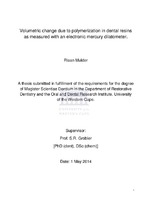| dc.description.abstract | Objectives: To determine the total volumetric change and the relative speed of shrinkage of bulk fill flowable composites during polymerization. Background: The volumetric change that occur during the polymerization of dental composite restorations are considered to be one of the most significant contributing factors when considering the failure in composite restorations. Volumetric shrinkage of more than 2% is considered to be enough to result in the occurrence of secondary caries resulting in fracture of restorations and failure in the adhesive layer of a resin restoration. The total volumetric change of dental resins can be attributed to three main factors: Firstly, the polymerization reaction that results in the formation of a polymer chain. Secondly, the increase of the exothermic thermal effects produced by the polymerization reaction and thirdly, light irradiance energy that is transferred to the dental resin. Materials and Methods: A specially designed electronic mercury dilatometer at the UWC Oral and Dental Research Institute was used to determine the volumetric change. The light intensity was set at 500mW/cm2. The mercury dilatometer measured the volumetric change every 0.5 seconds during the 35 second irradiation exposure time. The materials tested were Z250 as the control and four bulk fill flowable composites. The volume of voids within the cured material samples were assessed with a Micro-3D ct reconstruction (General Electric Phoenix). Results: The sequence of total volumetric change from least to most were: Z250 < Filtek bulk fill < Xtra-Base bulk fill < SDR < Venus bulk
fill. The speed/rate of shrinkage of the bulk fill flowable composites were faster than that of Z250, while the 2 bulk fill flowables with the highest shrinkage speed (SDR and Venus) also had the highest total volumetric change. Of the different materials tested the volumetric change of Z250 (1.13%) was the lowest and significantly less (p<0.05) than that of SDR (1.56%) and Venus (1.72%). The Kruskal-Wallis multiple comparison test indicated that the material with the highest filler content (Z250) also showed the lowest shrinkage (1.13%) but this effect of the filler content could not be seen in the bulk fill flowable composites. The volume of the voids within the test specimens were determined and were represented as a percentage of the cured volume (49.087mm³). Venus had the largest percentage of voids (1.18%) in the test specimen (specimen volume: 49.087mm³), followed by
Z250 with 0,5248%, Xtra base with 0,00015%, SDR with 0,00059% and Filtek bulk fill with 0,00069%. Conclusions: The volumetric changes and rate of shrinkage were higher for all 4 bulk fill flowable composites than for Z250. Furthermore, the speed of shrinkage based on the polymerization reaction differed between the materials. SDR and Venus flowables had the fastest rate and highest volumetric change. The small percentage of voids within the materials seemed not to have affected the volumetric change negatively. Clinical significance: The manufacturers of bulk fill flowable composites advocate filling layers of 4mm. However, because of the high shrinkage values found in this study the use of the standard 2mm layer increments is recommended. | en_US |

